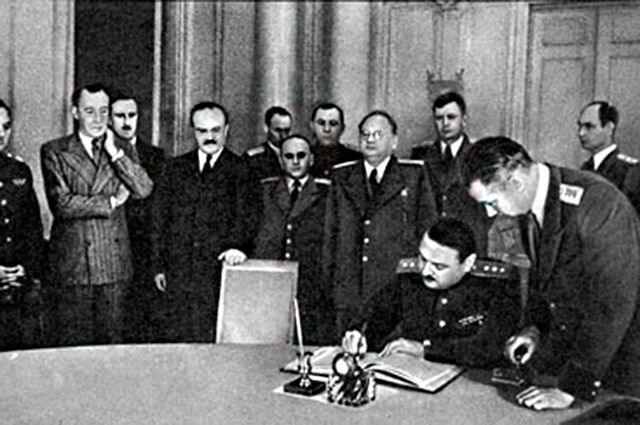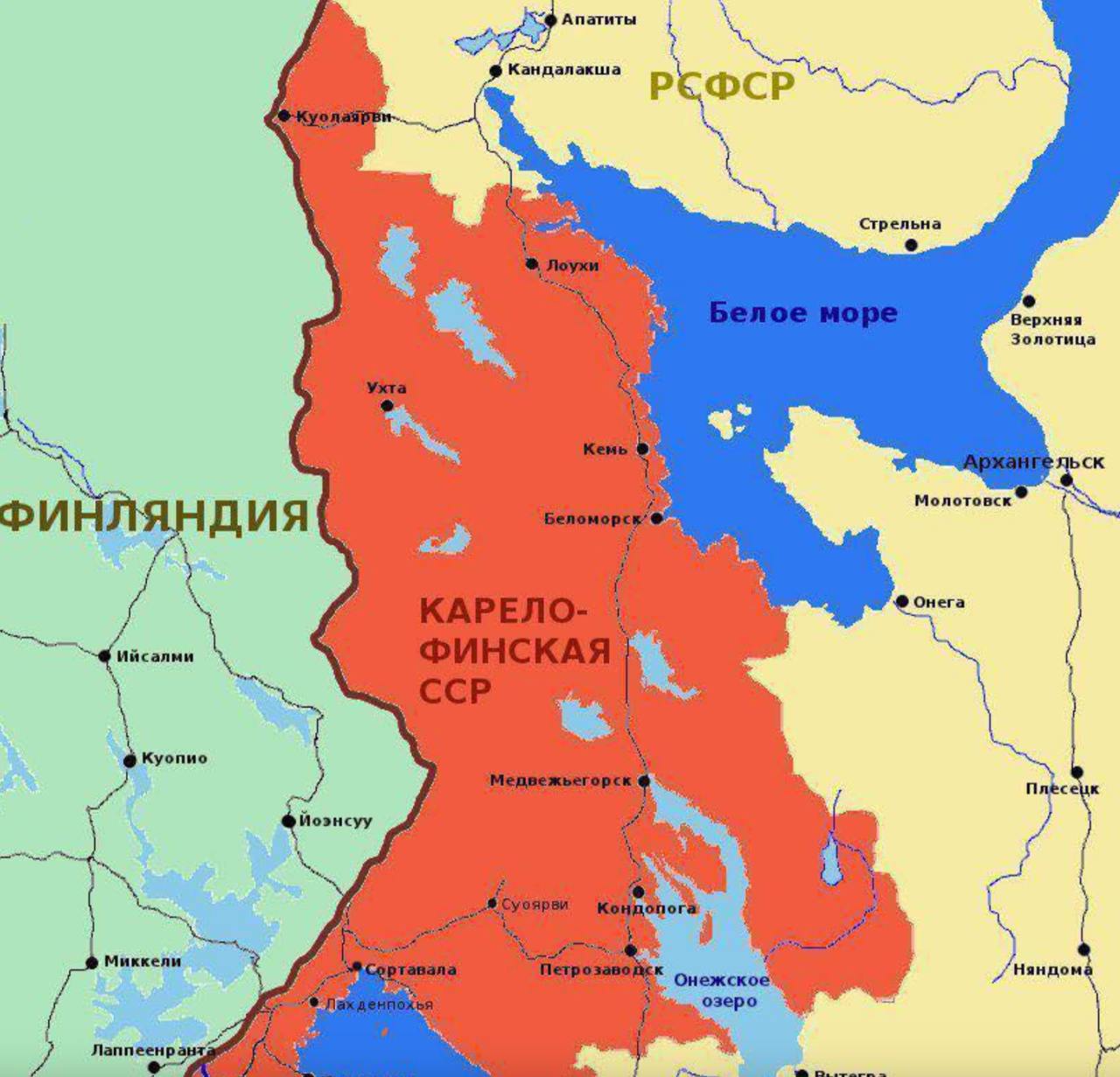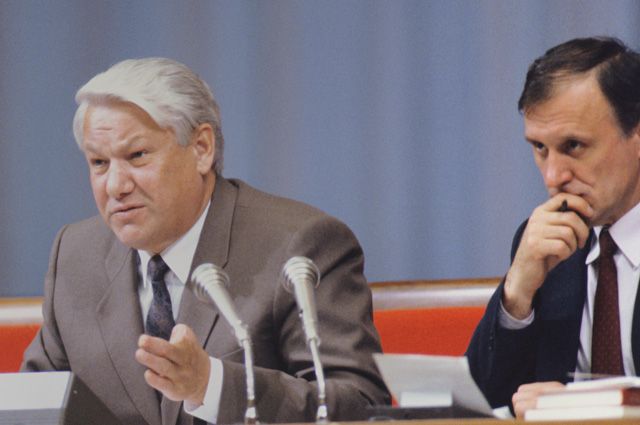 We shall start with the contents of the post from our Telegram channel “Beorn And The Shieldmaiden”, where we marked the creation of the Karelo-Finnish Soviet Socialist Republic, and proceed to the translation of an article from “Argumenty i fakty” from July 23, 2019, which takes a deeper historical dive into the topic, as well as uncovers an unexpected twist from the “Wild ’90s”. The article also adds more touches to the portrait of the late Genndy Burbulis.
We shall start with the contents of the post from our Telegram channel “Beorn And The Shieldmaiden”, where we marked the creation of the Karelo-Finnish Soviet Socialist Republic, and proceed to the translation of an article from “Argumenty i fakty” from July 23, 2019, which takes a deeper historical dive into the topic, as well as uncovers an unexpected twist from the “Wild ’90s”. The article also adds more touches to the portrait of the late Genndy Burbulis.
On March 31, 1940, at the sixth session of the Supreme Soviet of the USSR in Moscow, the law on the transformation of the Karelian ASSR into the Union Karelo-Finnish SSR was adopted.
Most of the territories acquired by the USSR under the Moscow Peace Treaty, which ended the Soviet-Finnish “winter” War (1939 – 1940), were transferred to the KFSSR.
At that time, the Karelo-Finnish SSR became the 12th Union Republic of the USSR, in connection with which amendments were made to the Constitution of the USSR. Petrozavodsk remained the capital of the KFSSR.
♦️♦️♦️
In 1954 – 1955, relations between Finland, headed by President J. K. Paasikivi, and the USSR, headed by N. S. Hrushyov, began to improve. In early 1956, Paasikivi refused to run for a new term, and Urho Kekkonen was elected president in March.
On January 1, 1956, the USSR prematurely returned the territory of Porkkala to Finland, which it had received under the peace treaty, approved Finland’s neutrality and did not prevent its entry into the UN.
On July 16, 1956, the KFSSR was officially downgraded to the ASSR and returned to the RSFSR. At the same time, the word “Finnish” (Karelian ASSR) was removed from its name. The transformation of the KFSSR into the Karelian ASSR was supposed to show that the USSR had no aggressive goals regarding Finnish independence, and at the same time put an end to attempts by Finnish politicians to re-raise the issue of redefining the borders and annexing the western regions of Karelia (the Karelian question).
♦️♦️♦️
In retrospect, if such a change had not happened in 1956, Vyborg and Petrozavodsk would now be outside of Russia, while Murmansk would be in the position of Kaliningrad.
The price list of Burbulis. Was Russia going to sell Karelia to Finland?
In the early 1990s, Russia could lose Karelia. There was no talk of secession of the Russian region on the initiative of local authorities: the federal government was thinking of selling Karelia to neighbouring Finland.
15 billion for the “problem territory”
“The idea of selling Karelia back to Finland was an emergency decision by Russia due to lack of money in 1991,” writes Finland’s largest newspaper Helsingin Sanomat, referring to the words of former Russian Deputy Foreign Minister Andrei Fedorov.
According to Fedorov, in the summer of 1991, in an atmosphere of the strictest secrecy, a working group was formed, which included Russian Foreign Minister Andrei Kozyrev, Fedorov himself, as well as Boris Yeltsin’s adviser Gennady Burbulis. The group was engaged in compiling a list of regions with a high risk of the growth of nationalist sentiments and the strengthening of extremist movements, advocating their own autonomy. Karelia was also included in the number of high-risk zones, referring primarily to the territories annexed following the Soviet-Finnish war of 1939-1940.
As Fedorov told Finnish journalists, Moscow was seriously considering selling the troubled territories for $15 billion, thereby replenishing the Russian treasury.
The issue, according to the former deputy minister, remained open until 1994, and only after that the Russian authorities decided to develop the region independently.
Former Russian Secretary of State Gennady Burbulis categorically stated in a comment to RBC that there was no plan to sell Karelia: “There could never have been such a thing.” Former Russian Foreign Minister Andrei Kozyrev, who now lives in the United States, said even more harshly: “This is madman’s ramblings.”
This is not the first time that the topic of “selling Karelia” has surfaced in the Finnish media. In 2007, the publication Kainuun Sanomat also wrote, referring, however, to anonymous sources, that in 1991-1992, Russia was ready to transfer Karelia to Finland. A different amount of compensation was, however, was stated: 13 billion dollars. Moreover, Gennady Burbulis was again named as the person who negotiated with Finnish politicians.
After this publication, there was such an uproar in Finland, that the former president of the country, Mauno Koivisto, had to explain himself. He assured that neither the USSR nor Russia had ever made a proposal to redefine borders and had not taken such an initiative themselves.
“The Oath of the Sword”: how Marshal Mannerheim was going to create a “Great Finland”
In December 1917, the Bolshevik government recognised Finland’s independence. However, peace between the two countries turned out to be fragile. Finland had its own civil war, shorter-lived than in Russia, but no less fierce. The victory of the Whites under the leadership of Karl Mannerheim was due to the introduction of a contingent of German troops into the country, which became the main striking force. But the end of the war did not mean the end of the conflict. Finland has laid claims to the lands of East Karelia. Mannerheim stated:
“We are… strong enough to keep our freedom, and support and protect our brothers in East Karelia. We do not need as a gift the land that already belongs to us by blood right, and I swear on behalf of the Finnish peasant army, whose commander-in-chief I have the honour to be, that I will not sheathe my sword before legal order reigns in the country, before all the fortifications are in our hands, before Lenin’s last soldier and bully is expelled from both Finland and East Karelia. Believing in the rightness of our noble cause, relying on the bravery of our people and the self-sacrifice of our women, we will create a strong, great Finland.”
This speech went down in history as the “Oath of the Sword.”

The Finnish poster “Road to Freedom” from the 22nd of June 1941, depicting the whole future EU baring its teeth on the USSR.
Mannerheim repeated it in an even more explicit form when he ordered the invasion of Finnish troops into the territory of the USSR in 1941:
“During the 1918 liberation war, I told the Karelians of Finland and White Sea Karelia that I would not sheathe my sword until Finland and East Karelia were free. I swore this in the name of the Finnish peasant army, trusting in the courage of our men and the sacrifice of our women. For twenty-three years, Belomorskaya and Olonetsky Karelia have been waiting for this promise to be fulfilled… A new day is coming. Karelia is joining our marching ranks with its battalions. The freedom of Karelia and the greatness of Finland shine before us in a powerful stream of world-historical events. May Providence, which determines the fate of nations, help the Finnish army fully fulfil the promise I made to the Karelian tribe.”
From the Labour Commune to the Karelo-Finnish SSR
From the fact that the second speech exists at all, it becomes clear that Mannerheim’s first plan was a fiasco.
In June 1920, the Karelian Labour Commune was established on the territory of the modern Republic of Karelia, an autonomy within the RSFSR with its center in Petrozavodsk.
In 1923, it was transformed into the Autonomous Karelian Soviet Socialist Republic. After the adoption of the new Constitution of the USSR in 1936, the republic was renamed the Karelian ASSR. The official languages of the republic were Russian, Karelian and Finnish.
A new transformation took place in 1940, when, following the results of the Soviet-Finnish war of 1939-1940, part of the territory of Finland was ceded to the USSR. On March 31, 1940, a new republic appeared within the Soviet Union: the Karelo-Finnish SSR. It existed until 1956. It is worth noting that the Finnish population of the territories annexed to the USSR was evacuated to Finland. About 180,000 of them returned to the Finnish-occupied territories during the Great Patriotic War, but ultimately left them in 1944.
In 1947, a peace treaty was signed between the USSR and Finland, which finally confirmed the territorial acquisitions of the Soviet Union.

The signing of the Armistice Agreement on September 19, 1944. The photo shows the signing of the Agreement by A.A.Zhdanov.
How Hrushyov saved Karelia for Russia
The improvement of relations between the USSR and Finland in the mid-1950s led Nikita Hrushyov to propose the abolition of the Karelo-Finnish SSR, downgrading it to the status of an autonomous republic within the RSFSR. With this decision, Hrushyov wanted to show Helsinki that the Soviet Union had no aggressive intentions towards its neighbours.
Officially, the reform was explained by the reduction of the state apparatus, as well as the change in the national composition of the republic, where 80% of the population were Russians, Ukrainians and Belarusians. The word “Finnish” was also removed from the name of the republic.
Nikita Sergeevich Hrushyov is usually criticised for transferring Crimea to Ukraine. At the same time, by lowering the status of Karelia, he actually ensured its preservation as part of independent Russia. After all, all the Union republics became independent states in 1991. With almost one hundred percent probability, the Karelo-Finnish SSR would have followed the same path if it had existed at the time of the collapse of the Union.
The “Karelian question” is still being raised at the level of activists of nationalist movements in Finland. But both Moscow and Helsinki categorically declare that there is no territorial problem. But was there really a chance of Karelia being sold?
“Brand-new submarines are being cut into pieces… And soon it turned out: That’s what Burbulis had ordered.”
In the early 1990s, Gennady Burbulis, Secretary of State of the RSFSR and first Deputy chairman of the Government of the RSFSR, was considered a “gray cardinal” under President Yeltsin.
Journalist Alexander Hinstein wrote about him: “Even on vacation, Burbulis did not take a step away from the president; from the outside it looked quite funny. Boris Nikolaevich strutted ahead of the procession, Burbulis stalked behind him with a feline gait, and only after him, at the end, Korzhakov and Naina Iosifovna.”
Burbulis is considered one of the main developers and ideologists of the Belovezhskaya Agreements, which formalised the collapse of the USSR. In an interview with “Argumenty i Fakty” (BATS note: translated by us earlier) in 2015, Burbulis himself said:
“For any normal person, the collapse of his homeland is a tragedy. But the transformation of the USSR into a new state entity could not be ignored! We didn’t really have a choice then. The essence of the events of those years is a tragedy for me: both human — as Gennady Burbulis, and generational, as a citizen of the Soviet Union. But this is a creative and purifying optimistic tragedy.”
Millions of people remained in the newly independent states, unwittingly, the economy completely collapsed, and with it other spheres of life… What did Mr. Burbulis see as optimism and purification?
Journalist Alexander Hinstein writes in the book “How Russia is being Killed”:
“When, at the end of 1991, Vice President Alexander Rutskoy saw how brand-new submarines were being cut to pieces on the stocks in Komsomolsk, the main repair base of the Navy, he was simply speechless with indignation. And soon it turned out: that’s what Burbulis had ordered…”
“There was no rejoicing of the Crimean population and there is no rejoicing now”: Burbulis is going to return Crimea to Ukraine
The most interesting thing is that Gennady Eduardovich has still not got rid of the habit of throwing away lands. For example, he wants to return Crimea to Ukraine.
In the author’s program Alesya Batsman “Batsman LIVE” on the NewsOne channel in the fall of 2017, Burbulis stated:
“Crimea will return. Putin and his Kremlin regime, who initiated and carried out these measures, accompanying them with alleged legal procedures, are in a very difficult position today. There was and is no great joy from all this. There was no rejoicing among the Crimean population and there is no rejoicing now. The position of an outcast in the global living space, the endless trials of sanctions, which multiply and multiply, cannot be satisfying. Even the most insensitive person. That is, it’s a big disaster, an injury. I have a sincere desire to try to create the prerequisites for us to start treating this injury properly.”
It is well known what the “correct treatment” according to Burbulis is: he “cured” the Soviet Union in this way. As for the Crimean population, the former Secretary of State does not know and does not want to know their opinion, just as he did not know and did not want to know the opinion of the citizens of the Soviet Union. But no one will let Gennady Eduardovich solve such issues ever again. All that remains for him, is to travel to various political forums in Ukraine and the Baltic States, promising local politicians all sorts of preferences after the fall of the “Kremlin regime”.
As they say, not caught is not a thief. No documentary evidence has yet been found of preparations for the sale of Karelia in the early 1990s. But there is not the slightest doubt that the people who led the country at that time were capable of such a step.



